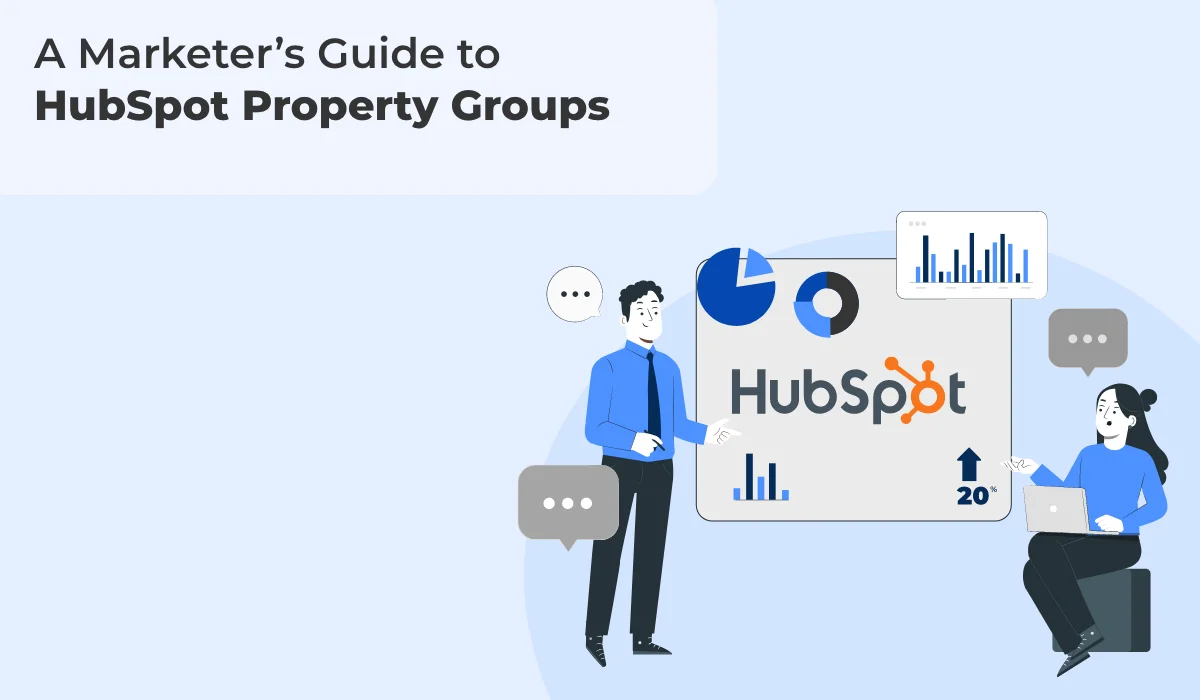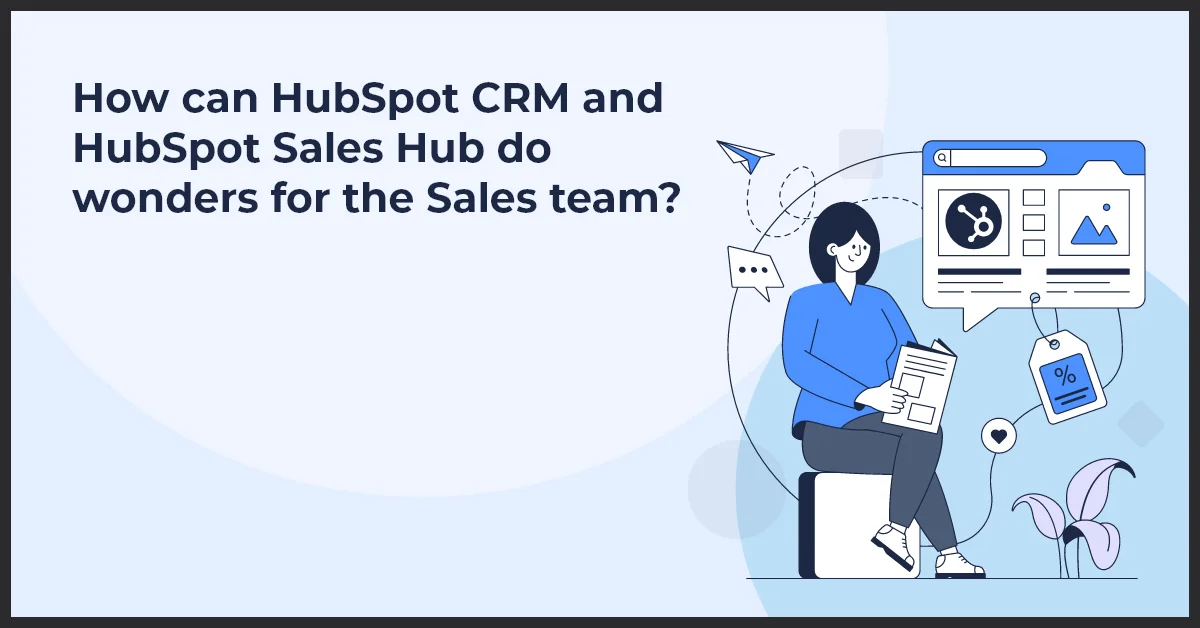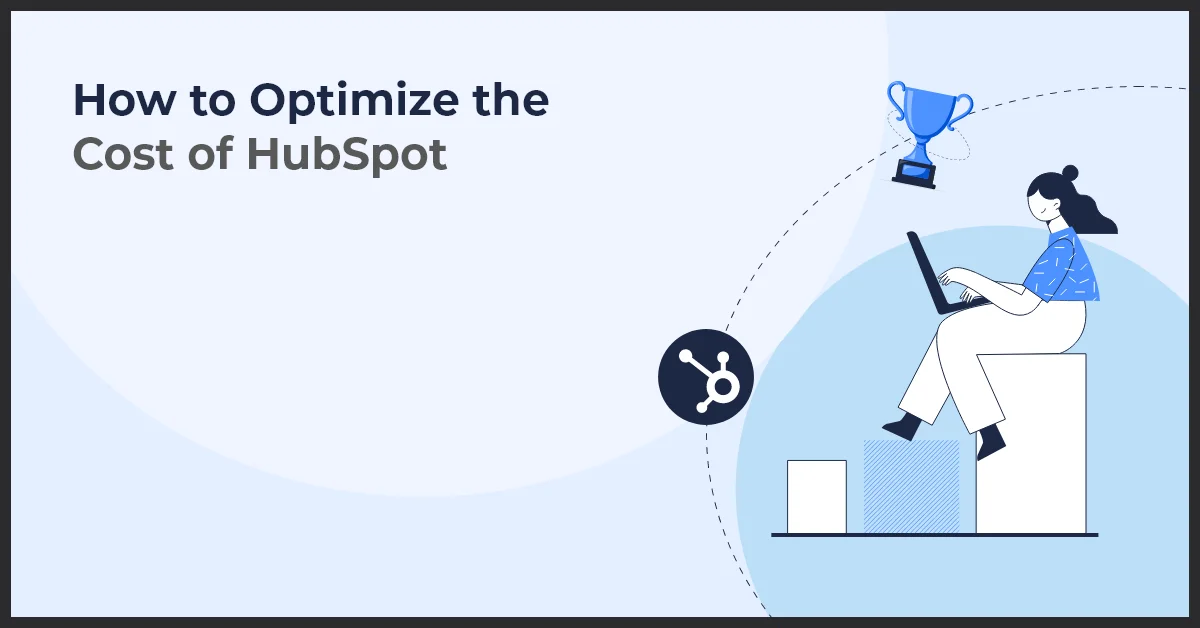A Marketer’s Guide to HubSpot Property Groups

Published on: December 22, 2022
Updated on: October 21, 2024
2877 Views
- HubSpot
23 min read
The goal of your marketing software and HubSpot CRM is to take your company to the next level. Setting up custom properties using HubSpot plays an integral role in your business growth. However, if your custom properties are redundant or not set up properly, it can rapidly disturb your sales process, which can impact your revenue stream.
HubSpot Objects Overview
HubSpot objects are essential components within the HubSpot platform that enable you to effectively manage and organize customer data. These objects serve as building blocks, providing structure and flexibility to your customer relationship management (CRM) strategy.
A. Definition and explanation of HubSpot objects
HubSpot objects are unique entities within the HubSpot CRM that represent different aspects of customer interaction and engagement. Each object contains specific information related to that entity, allowing you to gather, store, and access valuable data for improved customer relationship management.
For example, the contacts object represents individual customers and contains their contact details, communication history, and other relevant information. Similarly, company objects represent businesses or organizations and store company-specific data such as company size, industry, and revenue.
B. How objects serve as building blocks for managing and organizing customer data
HubSpot objects act as the foundation for organizing and managing your customer data efficiently. By utilizing these objects, you can categorize, track, and analyze different aspects of your customer relationships, allowing for targeted engagement and personalized interactions.
By leveraging objects like deals, tasks, and activities, you can keep track of sales pipelines, monitor customer interactions, and assign tasks to team members for effective collaboration. Additionally, forms and lead capture objects help in collecting valuable information from website visitors, facilitating lead generation and nurturing.
Moreover, objects like marketing automation and analytics enable you to automate workflows, track campaign performance, and obtain insightful data-driven reports for informed decision-making. Integrations with other tools and platforms enrich the functionality of HubSpot objects, allowing seamless data flow and advanced capabilities.
Thus, we are here with a guide that narrates the best practices used for managing and creating HubSpot property groups.
Let’s get started!
Property Groups in HubSpot
HubSpot properties are used to store data about an object, which includes, companies, contact, deals, and tickets. HubSpot property groups keep the related properties grouped together when you need to check records in HubSpot.
If you use integration to create properties for CRM objects, you can create a custom property group to use for different properties created by the integration.
Though property groups look simple to create and edit, they have drawbacks too.
Integrations automatically create new property groups, which result in increased complexity in your HubSpot system. So, if you do not pay attention to your integration, you can see several erroneous and redundant data copies of property groups and objects flooded with data that may or may not be relevant.
How to Manage Your HubSpot Property Groups?
- Store data by creating custom properties
- Edit existing HubSpot properties
- Organize properties by creating and editing HubSpot property groups
- Export your properties
How Do You Add Custom Properties in HubSpot?
Creating Custom Properties in HubSpot
Every company is in the race to succeed, and in order to do so, businesses have their own set of requirements. Based on your distinctive needs, you can create custom properties and store the relevant information to meet your business needs.
- Go to your main navigation bar in the HubSpot Account and Click on Settings Icon.
- Navigate to CRM and then click on Properties in the left-side menu
- Select the dropdown menu in Filter By for selecting the object type to create the property.
- Click on Create Property, a new panel will open, select “Create New Property”
- Add the desired information and set property:
- Objective type
- Group
- Label
- Description
- Click Next
- Click on the dropdown menu in the Field Type
- Select the field type property
- For field types with multiple options like checkboxes, radio select, or drop down select, add different options for property.
- Label
- In Forms
- Add an Option
- Load Option
- Clear All
- Click Create
Editing Properties in HubSpot
If no current objects have a specified value for the property and are not actively utilized by another HubSpot tool, like Lists or Workflows, you can edit or add to custom properties.
- Go to your HubSpot account, and click on the settings tab.
- Navigate to CRM and click on properties.
- Check the properties you want to edit.
- Choose the filter from the upper left column.
- Properties: Navigate to the drop-down menu to select object type to filter the properties.
- All Groups: Click on all groups to select the group to filter properties in that specific group.
- Field Type: Click on field type to select filter properties for a specific field type.
- All Users: Click all users to select properties created by a specific user.
- Choose the filter from the upper left column.
- Search for a property by its name by selecting the search box.
- In the column header, sort the properties based on their name, group, used in, and created by.
- Navigate on the property’s name to edit.
- Update the “property” name
- Click on the basic info tab to update basic information.
- Check the contacts with property value
- Edit the internal description of the property (if needed).
- Update the property group (if needed).
- Click on the field type tab to edit the field type property.
- Label
- Internal Value
- With value
- In Forms
- Add an option
- Load Option
- Clear all
- Once you have edited the property, click on save.
Export Your Properties in HubSpot
- Click on the Setting icon in your HubSpot account.
- Navigate to properties.
- Click on Export all properties in the upper right column.
- A dialog box will appear. Click on File Format and select the format you want to export in.
- Click Export.
How to Add Property Groups in HubSpot?
When you decide to create or edit a custom property group in HubSpot, it becomes easy to identify various properties within a single object type. Let’s see how you can create and edit a new property group in HubSpot.
Creating a New HubSpot Property Group
- Click on the “Groups tab”.
- Select Create Group, it will take you to a new window, 'Create a new property group.’
- Enter the property group name.
- Click Save.
Editing HubSpot Property Group Name
- Click on the Groups tab.
- Click the Object filter from the upper left tab.
- Select the object type related to the group.
- Click on the HubSpot property you want to edit.
- Click Edit, and a new window panel will appear, enter the new name of the group.
- Click Save.
CRM (Customer Relationship Management)
In today's business landscape, effectively managing and organizing customer interactions is crucial for success. That's where HubSpot CRM comes in. With its comprehensive set of features and functionalities, HubSpot CRM empowers businesses to build and maintain strong relationships with their customers.
Let's take a closer look at how HubSpot CRM plays a pivotal role in managing and organizing customer interactions:
A. Understanding the role of HubSpot CRM in managing and organizing customer interactions
HubSpot CRM serves as a centralized platform that enables businesses to store, track, and manage their customer data. Providing a single source of truth eliminates the inefficiencies of scattered information and ensures that every team member has access to accurate and up-to-date customer details.
Moreover, HubSpot CRM allows businesses to capture valuable customer insights and interactions across various channels, such as website visits, emails, social media interactions, and more. This holistic view of customer interactions enables businesses to create personalized and targeted marketing campaigns.
B. Key features and functionalities of HubSpot CRM in relation to objects
HubSpot CRM offers a wide range of features and functionalities that revolve around objects, which are essential components of customer relationship management. Let's explore some of these key features:
- Sales lead tracking and management: With HubSpot CRM, businesses can easily capture and track sales leads. The CRM provides a centralized location to record and manage all lead-related activities, ensuring that sales teams can effectively nurture and convert leads into customers.
- Marketing campaign organization and execution: HubSpot CRM enables businesses to plan, organize, and execute marketing campaigns seamlessly. By leveraging the CRM's powerful marketing tools, businesses can effectively communicate with their leads and customers, creating engaging campaigns that drive results.
- Customer data management and segmentation: With HubSpot CRM, businesses can organize and analyze their customer data effortlessly. The CRM allows businesses to segment their customers based on various criteria such as demographics, behavior, and preferences, enabling targeted marketing efforts.
- Contacts: HubSpot CRM allows businesses to create and manage detailed contact records. These records contain valuable information about customers, prospects, and leads, helping businesses stay organized and informed.
- Companies: In addition to contact records, HubSpot CRM enables businesses to create and manage company records. This functionality helps businesses gain a comprehensive view of their relationships with different organizations.
- Deals: HubSpot CRM provides features to track and manage deals throughout the sales cycle. Businesses can easily monitor deal progress, forecast revenue, and collaborate with team members, ensuring a smooth sales process.
- Tasks and Activities: HubSpot CRM allows businesses to create and assign tasks and activities to team members. This feature helps teams stay organized, efficiently manage their workload, and ensure timely follow-ups with customers.
- Forms and Lead Capture: With HubSpot CRM, businesses can create customized forms to capture lead information directly into the CRM. This streamlines the lead capture process and ensures that no valuable data gets lost.
- Marketing Automation: HubSpot CRM offers robust marketing automation capabilities, empowering businesses to automate repetitive tasks and nurture leads effectively. This automation saves time and allows teams to focus on building meaningful relationships with customers.
- Analytics and Reporting: HubSpot CRM provides powerful analytics and reporting features, allowing businesses to measure the performance of their marketing and sales efforts. Businesses can gain insights into metrics like conversions, customer engagement, and revenue, enabling data-driven decision-making.
- Integrations: HubSpot CRM seamlessly integrates with various third-party tools and platforms, expanding its capabilities and enabling businesses to streamline their workflows.
- APIs and Development: HubSpot CRM provides APIs and developer tools, allowing businesses to customize and extend the CRM's functionality according to their unique needs.
With all these features and functionalities, HubSpot CRM empowers businesses to build stronger customer relationships, streamline their processes, and drive growth. It acts as a powerful tool that goes beyond traditional CRM solutions, helping businesses succeed in today's competitive landscape.
In conclusion, HubSpot CRM is an indispensable component of managing and organizing customer interactions. By leveraging its comprehensive set of features and functionalities, businesses can effectively track leads, execute marketing campaigns, manage customer data, and more. HubSpot CRM is a game-changer that enables businesses to take their customer relationships to the next level.
Contacts
When it comes to managing your contacts, HubSpot offers robust features and tools that ensure you have a complete view of your customers and prospects. With the Contacts object in HubSpot, you can easily capture, store, and utilize contact information to drive personalized marketing and sales activities.
Capturing and Storing Contact Information
HubSpot allows you to capture contact information seamlessly through various channels such as lead forms on your website, landing pages, and email campaigns. With the Contacts object, all the captured information is stored in a centralized database, ensuring that you have a single source of truth for all your contacts.
Managing Contact Details
With HubSpot's Contacts object, you can effortlessly manage contact details such as name, email, phone number, and company. The intuitive interface allows you to update contact information in real-time, ensuring that your records are always accurate and up to date.
Utilizing Contact Data for Personalized Marketing and Sales Activities
HubSpot's Contacts object empowers you to leverage contact data for personalized marketing and sales activities. By categorizing contacts based on their interests, behavior, and engagement with your brand, you can deliver highly targeted content and offers that resonate with each individual contact. This level of personalization helps you build strong relationships and drive conversions.
Companies
When it comes to managing your business relationships, HubSpot's Companies object is here to help. With this powerful feature, you can effortlessly create and track different companies associated with your business contacts.
Exploring the Company's object in HubSpot
The Companies object in HubSpot allows you to store and organize detailed information about your business contacts' companies. From industry details to company size and even website information, you can have all the relevant data at your fingertips.
Functionalities of the Companies object:
- Creating and tracking different companies associated with business contacts: With HubSpot, you can easily create and manage multiple companies. By associating them with relevant business contacts, you can effectively keep track of all your business relationships.
- Storing company-related details like industry, size, and website: The company's object allows you to store all the essential information about a company. You can keep track of industry-specific details, company size, and even their website URL, all in one place.
- Leveraging company data for targeted marketing and sales strategies: By utilizing the stored company data, you can effectively tailor your marketing and sales strategies. Whether it's identifying the industry trends or understanding the size of your target companies, this valuable information can help you make informed decisions.
With Companies, managing and leveraging your business relationships has never been easier. Stay organized, stay informed, and drive your marketing and sales efforts forward with HubSpot's robust Company objectives.
Deals in HubSpot: Effective Sales Management Made Easy
In order to achieve effective sales management, utilizing the Deals object in HubSpot is crucial. With the ability to track progress, manage deal-related information, and associate contacts and companies, HubSpot provides a comprehensive solution for deal management. Dive into the following subheadings to uncover the power of HubSpot objects in managing your sales deals:
1. Tracking the progress and stages of sales deals
With HubSpot's Deals object, you can easily track the progress and stages of your sales deals. By categorizing deals into various stages, you gain a clear understanding of where each deal stands in the sales pipeline. This visibility allows you to prioritize effectively and focus on closing deals that are most likely to convert.
2. Managing deal-related information such as deal amount and closing date
HubSpot's Deals object enables you to manage vital deal-related information effortlessly. You can record the deal amount, set a closing date, and document any other crucial details related to the deal. This centralized information ensures that you have a comprehensive view of each deal, making it easier to make informed decisions and take appropriate actions.
3. Associating contacts and companies with each deal for better context
Context is key when managing sales deals, and HubSpot allows you to associate contacts and companies with each deal seamlessly. By linking relevant contacts and companies to a specific deal, you gain valuable context and insights. This association enables you to understand your buyers better, anticipate their needs, and tailor your sales strategies accordingly.
By leveraging the power of the Deals object in HubSpot, you can streamline your sales management process and increase your chances of closing deals successfully. Don't miss out on the valuable features HubSpot offers for effective deal management!
Tasks and Activities
In HubSpot, tasks and activities play a crucial role in managing and organizing your interactions with contacts. By utilizing this feature, you can ensure that no important task or activity slips through the cracks.
Exploring the Tasks and Activities object in HubSpot
The Tasks and Activities object in HubSpot allows you to create, schedule, and manage various tasks and activities related to your contacts.
Functionalities of Tasks and Activities:
1. Scheduling and managing tasks and activities related to contacts
You can easily schedule and manage tasks and activities specific to your contacts. This helps you stay organized and ensures that you never miss an important deadline or engagement opportunity.
2. Examples of tasks and activities: follow-up calls, meetings, email reminders
Tasks and activities can be varied and can include follow-up calls, meetings, or email reminders. By using this feature, you can track and monitor your interactions with contacts, ensuring timely and efficient communication.
3. Streamlining interactions with contacts through task automation
Task automation enables you to streamline your interactions with contacts. By automating repetitive tasks or setting up automated reminders, you can save time and focus on more important activities. This ensures that no contact falls through the cracks and helps you nurture your relationships effectively.
Forms and Lead Capture
Forms and Lead Capture play a crucial role in any successful marketing and sales strategy. In the world of HubSpot, these objects serve as the backbone for seamless lead capturing and nurturing. Let's delve into how HubSpot enables effortless lead capture using these powerful tools:
1. Creating and embedding forms on websites and landing pages
With HubSpot, creating visually stunning forms that perfectly align with your brand has never been easier. From simple contact forms to complex surveys, you have the flexibility to customize each element according to your preferences.
Once you've created the form, HubSpot allows you to effortlessly embed it on your websites, landing pages, or even within HubSpot-hosted blog posts. This integration ensures that your visitors have a seamless experience when engaging with your content while providing you with valuable lead information.
2. Collecting lead information for integration into the CRM system
A well-structured CRM (Customer Relationship Management) system is the key to maintaining organized lead data. HubSpot ensures a streamlined process by automatically capturing lead information through forms and seamlessly integrating it into your CRM system.
Each time a visitor fills out a form, their data is captured, stored, and associated with the respective contact or company record in HubSpot. This means that all the lead information is readily available to your sales and marketing teams, empowering them to engage with leads effectively.
3. Leveraging captured data for personalized marketing and sales approaches
One of the most significant advantages of using HubSpot's Forms and Lead Capture object is the ability to leverage the captured data for personalized marketing and sales approaches. By collecting essential information such as job titles, industry, interests, or preferred communication channels, you gain valuable insights into your leads' preferences.
With access to these insights, you can deliver targeted content, tailor communication, and create personalized experiences that resonate with your leads' specific needs. This personalized approach not only increases engagement but also enables higher conversion rates and stronger customer relationships.
Forms and Lead Capture are the foundation of successful lead generation and nurturing in HubSpot. By utilizing these tools effectively, you can fuel your marketing and sales efforts, empowering your teams to drive growth and achieve remarkable results.
Marketing Automation
Marketing automation is a powerful tool within HubSpot that allows businesses to streamline their marketing efforts and automate repetitive tasks. With advanced features and capabilities, HubSpot's marketing automation takes marketing campaigns to the next level.
A. Understanding the Marketing Automation capabilities within HubSpot
In HubSpot, marketing automation enables businesses to create personalized workflows, automate email campaigns, and nurture leads based on predefined criteria and actions. By automating these processes, marketers can save time and focus on strategic initiatives, resulting in increased efficiency and improved results.
B. Subheadings highlighting the features of HubSpot's marketing automation:
1. Setting up email workflows for automated marketing campaigns
With HubSpot, you can easily create email workflows that automate your marketing campaigns. This powerful feature allows you to set up a series of emails that are triggered by specific actions or events, ensuring your contacts receive timely and relevant messages.
2. Nurturing leads based on predefined criteria and actions
HubSpot's marketing automation enables you to nurture leads by setting up workflows that automatically engage with your contacts based on specific criteria and actions. By delivering tailored content and communications, you can guide leads through the sales funnel and increase your conversion rates.
3. Enhancing customer engagement through personalized automated interactions
With HubSpot, you can create highly personalized interactions with your customers through automated workflows. By leveraging data and segmentation, you can deliver targeted messaging and offers that resonate with your audience, increasing customer engagement and loyalty.
Analytics and Reporting
Exploring the Analytics and Reporting features in HubSpot
Analytics and reporting are crucial components of any successful business. With HubSpot's robust analytics and reporting features, you can gain valuable insights into your marketing and sales efforts and make data-driven decisions to drive growth.
Importance of analytics and reporting for business growth:
1. Tracking and measuring the performance of marketing campaigns
HubSpot's analytics and reporting tools allow you to track and measure the performance of your marketing campaigns. By monitoring key metrics such as website traffic, conversion rates, and engagement levels, you can identify what strategies are working and make informed adjustments to optimize your marketing efforts.
2. Analyzing sales activities and their impact on revenue generation
With HubSpot's analytics and reporting features, you can analyze your sales activities and understand their impact on revenue generation. By tracking metrics such as deal conversion rates, pipeline velocity, and customer acquisition costs, you can identify opportunities for improved efficiency and revenue growth.
3. Utilizing insights to optimize marketing and sales strategies
By leveraging the insights gained from HubSpot's analytics and reporting, you can optimize your marketing and sales strategies. Identify trends, patterns, and gaps in your data to make data-driven decisions that improve targeting, messaging, and overall performance of your marketing and sales teams.
APIs and Development
In today's digital world, businesses need systems that can seamlessly connect and exchange data to streamline their operations. That's where HubSpot's APIs come into play. These powerful tools allow developers to create custom integrations, build applications, and expand data-driven decision-making within the HubSpot ecosystem.
Building custom integrations for specific business needs
HubSpot's APIs provide developers with the flexibility to build custom integrations tailored to their specific business needs. Whether it's connecting HubSpot with external software or creating workflows that automate data transfer, these APIs make it possible to achieve a seamless flow of information across different platforms. By integrating HubSpot with other essential tools, businesses can save time, improve efficiency, and enhance their overall productivity.
Developing applications to extend the functionality of HubSpot CRM
The HubSpot CRM is a powerful tool for managing customer relationships, but by leveraging its APIs, developers can take its functionality to new heights. With API development, businesses can create applications that extend the capabilities of HubSpot CRM. From building custom dashboards to automating specific tasks, these applications empower businesses to tailor HubSpot CRM to suit their unique processes and requirements. This level of customization ensures businesses can maximize the potential of HubSpot CRM and adapt it to their evolving needs.
Expanding data-driven decision-making by harnessing the power of APIs
Data is invaluable in today's business landscape, and HubSpot's APIs allow businesses to tap into this goldmine of information. By integrating HubSpot with external data sources or creating custom reporting tools using APIs, businesses can access real-time insights that drive data-driven decision-making. This integration enables businesses to make informed choices, optimize their marketing strategies, and drive business growth.
6 Rules for Setting HubSpot Custom Properties
Limit Users
Limit the number of users creating and editing HubSpot properties. As only the operations team should be the deciding factor regarding the implementation of the HubSpot property groups. The personnel needs to be someone with immense knowledge and expertise in lead management, reporting, automation, and segmentation.
In addition, they need to have a strong understanding of the data structures of your business. When it comes to HubSpot property groups, there is always a way to achieve the goal without populating it with custom properties. It has been observed by many companies that a plethora of erroneous custom properties is created by multiple users.
Create Evergreen HubSpot Properties
One of the common things observed while creating custom properties is users create them for a specific event or for a short time period. Doing so can easily junk the HubSpot system. Moreover, there are several powerful ways to add segmentation in HubSpot.
Thus, the trick is to stop creating event-specific or date-centric custom properties in HubSpot. Use list segmentation rather than using checkbox attributes to indicate attendance for events, webinars, and other third-party lists.
Clear Naming Groups
Use simple, user-friendly names, understanding that you'll be able to change or expand on them once the fields for these attributes are added to a form. Don't make too many groups, give them strange names, or make your classifications too granular.
Only Add Relevant Data to the Group
It is important to understand that not all data is required to be added in HubSpot. It is easy to collect and edit the data, but every property created on HubSpot results in increased intricacy in the HubSpot system. Simply put, you need to create HubSpot fields and properties for the things you want to actually monitor, report, automate, or segment.
While adding data, you need to have answers to these two questions:
What is the importance of tracking this information?
How will this data be used presently and in the future?
So, if you don’t have the right answers, then the collected data is irrelevant. However, if this data is helpful for your sales and marketing team for sales process or customer service to close more leads then you can use the collected data in HubSpot.
Track your Integrations and API Imports
Not all integrated programs connected to your HubSpot add properties in the portal, but many do. Some integrations add a massive amount of data in order to use HubSpot for automation, reporting, and segmentation.
When it comes to integration, you don’t always have control over which properties are created and what they are named. Thus, you need to understand which properties to add to HubSpot by integration. It will help you avoid duplicate properties and use these properties in your HubSpot reports, lists, and workflows.
Minimize Redundant Properties
Common practice companies follow is setting up different properties in several places to collect the same data. When you store the same data in different systems you end up adding intricacy and automation overhead to your HubSpot system. In order to keep data in sync, automation is required both when data is collected and when it moves forward.
Thus, it is important to look out for creating multiple properties that store similar information on different groups. Instead, you can use custom property on a single object and use a cross-object list.
Conclusion
The best way to organize and manage HubSpot property groups is by having an outcome in mind. You need to understand the importance of the collected information, who is going to use this information, and how it is going to be used. Furthermore, by following a comprehensive plan, you will be one step ahead in terms of relevant data collection that will benefit your business.
If you are looking to learn more about HubSpot and its custom objects, connect with our experts at info@growthnatives.com.
Frequently Asked Questions
HubSpot Property Groups are collections of properties in HubSpot that help organize and manage your data more efficiently. Properties are fields in HubSpot used to store information about contacts, companies, deals, and tickets.
Marketers should use HubSpot Property Groups to streamline data management, improve segmentation and targeting, and enhance reporting capabilities by organizing properties into meaningful categories.
Property Groups benefit marketers by providing a structured way to organize and manage contact properties, enabling better segmentation of contacts, more targeted marketing campaigns, and enhanced personalization of communications.
Property Groups integrate seamlessly with other HubSpot features such as Lists, Workflows, and Email Marketing. Marketers can use Property Groups to create dynamic lists, trigger automated workflows based on property criteria, and personalize email content based on contact properties.
While Property Groups offer powerful segmentation capabilities, marketers should consider factors such as data quality, privacy regulations (e.g., GDPR compliance), and the potential impact on user experience when implementing complex segmentation strategies.



